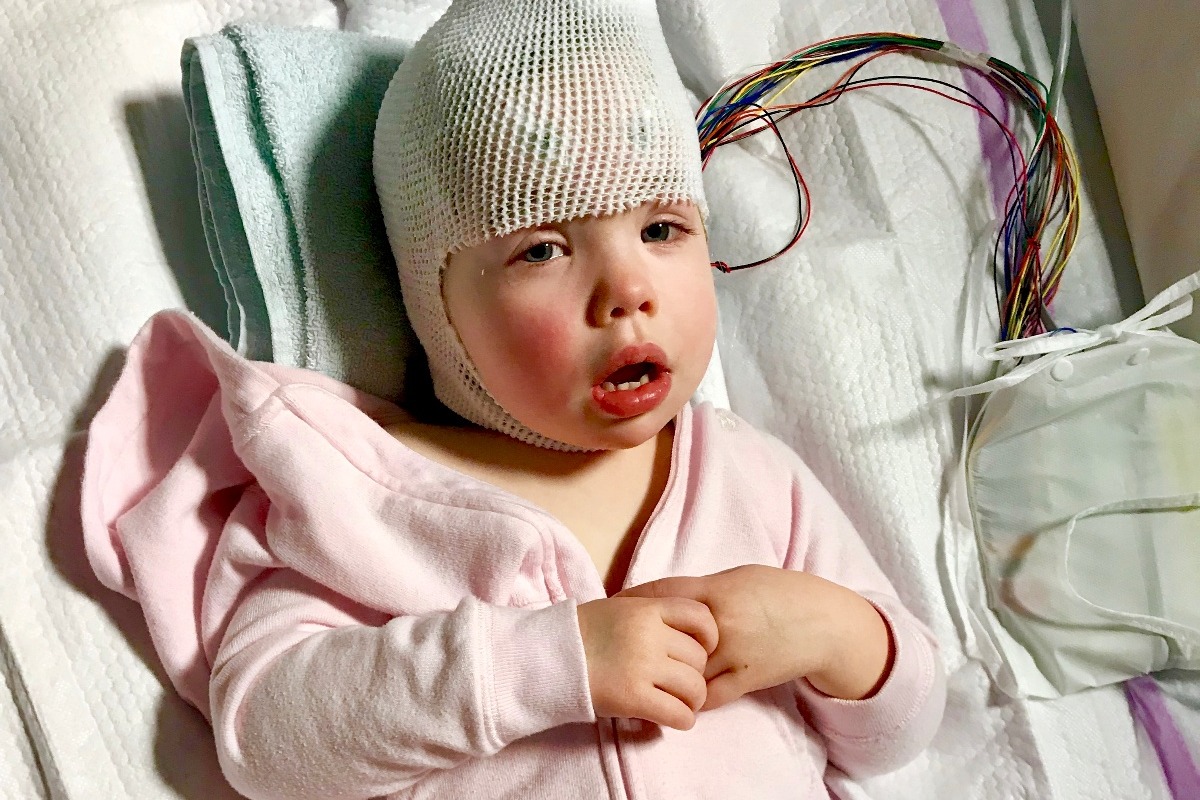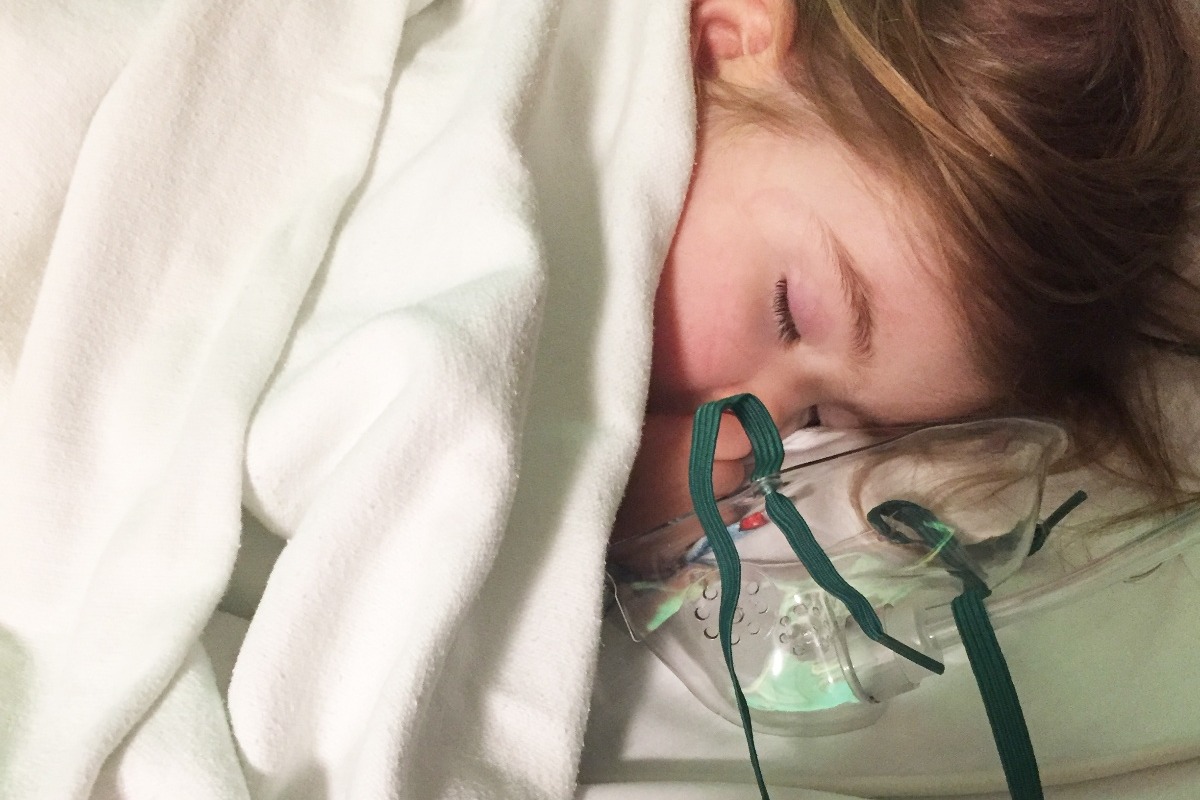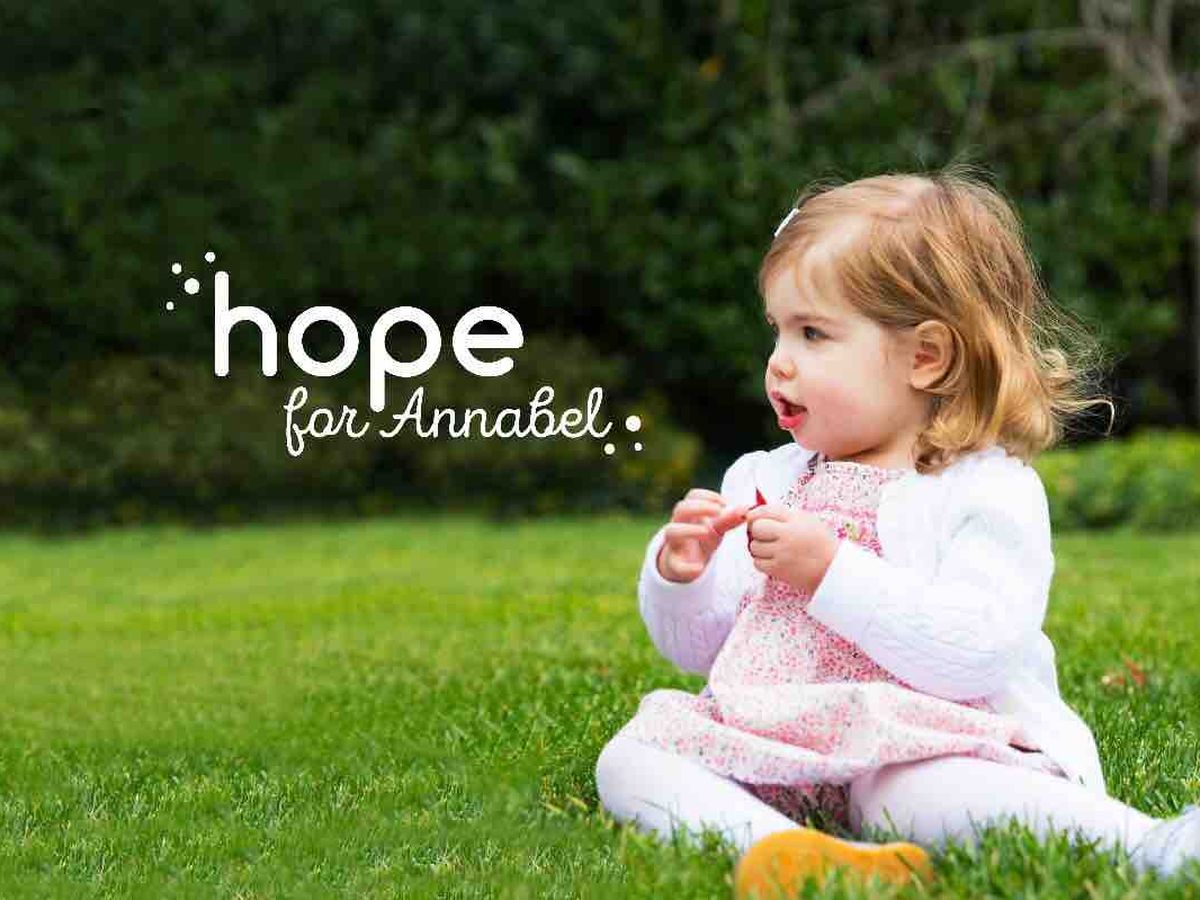Annabel is fighting a severe and very rare disease called Alternating Hemiplegia of Childhood. A cure is within reach. She needs your help to fight back.
What would you do if your child were diagnosed with an extremely rare and severe disease with no cure, no effective treatment, and minimal funding for research? This is our reality.
There is hope, however. The path forward for Annabel, and for countless other children suffering from genetic disorders, is gene therapy. We believe we have found a path to a cure for Annabel, and for other suffering children like her.

Meet Annabel
Annabel is a curious and affectionate two year old, who loves her family, hopes to be just like her big sister, and always wants to read The Wheels on the Bus. She also suffers from a rare neurological disorder called Alternating Hemiplegia of Childhood (AHC).
Every three or four days, Annabel has an “episode,” much like an epileptic seizure. These episodes can include paralysis, painful dystonia, or uncontrolled muscle spasms, and a reduced level of consciousness, and can last for days.
Each time she has an episode, her brain may be damaged. Over time, brain atrophy can rob her permanently of the hard-fought progress she has made. While her speech, motor and cognitive function are significantly delayed now, they are likely to be compromised further as she gets older.

A terrifying percentage of AHC patients also suffer from a severe episode that causes sudden and irreversible degeneration: they are left bedridden and unable to talk, for the rest of their lives. In other cases, failure in the autonomic nervous system related to AHC can cause sudden and unexplained death. We don’t know if or when this will happen to Annabel.
Despite her painful and disorienting symptoms, and her special needs, Annabel doesn’t let AHC rob her of her zest for life. Her symptoms were particularly severe on Easter, with a prolonged spell of reduced consciousness and distressing dystonia that lasted much of the day. Even though she could not walk or even crawl independently, Annabel joyfully hunted out Easter eggs and playfully tried to eat far more candy than she was allowed. This is her typical response to her episodes: she often continues to play, or giggle, or blow kisses even as she suffers from her symptoms. She faces her life bravely and joyfully–we want to give her the ability to keep fighting even harder.
With so few AHC patients, Annabel’s hope for a cure has been limited: there simply has not been enough research or enough funding underway to find a cure in time to change her life. That is about to change.
Learn more about Annabel's Story

What is Alternating Hemiplegia of Childhood?
AHC is a neurological disorder caused by an ion imbalance in the brain that prevents the correct functioning of neurons. It is associated with devastating outcomes like death, brain atrophy, and sudden and permanent degeneration.
AHC is a very rare condition, with only 300 known cases in the United States and 1,000 in the world. Annabel’s specific genetic mutation has only been identified in two other patients in the world.
For patients, AHC is like having seven diseases at one time:
Paralysis like stroke. Patients experience debilitating periods of paralysis, which can last for over a week.
Seizures and spells of reduced consciousness like epilepsy. These episodes carry a high risk of rapid, severe, and permanent deterioration. Clinical epilepsy occurs in more than 50% of AHC cases.
Low muscle tone like cerebral palsy. Low tone contributes to other serious complications, including the inability to breathe and swallow properly.
Movement problems like Parkinson’s. Patients often experience painful dystonia or involuntary muscle contractions.
Neurodegeneration like Alzheimer’s. Brain atrophy can cause a decline in motor function, learning capacity, memory, and the ability to breathe, eat and swallow as patients reach adulthood.
Behavioral issues like ADHD. Patients may have behavioural issues driven in part by pain, frustration, fear and cognitive dysfunction.
Learning challenges like autism. Patients can have cognitive challenges and difficulty with speech, learning, and psychological issues.
Learn more about AHC

Now, the Path to a Cure is in Sight
We believe we have identified a path to a viable permanent treatment for Annabel: gene therapy.
Gene therapy provides a path to a cure for AHC. A similar approach has already been successful in many diseases like Batten’s disease, Friedreich’s Ataxia, Huntington’s disease, Niemann-Pick disease, Parkinson’s disease, Rett Syndrome, Giant Axon Neuropathy, Multiple Sclerosis, Spinal Muscular Atrophy, and multiple retinal disorders. This is not only cutting-edge science, but also a proven, effective, and permanent fix of the genetic code. It will be delivered by a one-time injection into the cerebrospinal fluid and is designed to permanently correct the dysfunction caused by a mutated gene. Unlike drugs, gene therapy targets the source of the problem: DNA. In many diseases it permanently corrects the dysfunction caused by a problematic gene.
Leading scientists from several top universities and scientific institutions have agreed to participate in a collaborative international scientific effort to pursue the delivery of gene therapy for AHC. We have gathered and engaged the most experienced scientists in the fields of mouse viral therapy design and production, preclinical mouse research, toxicology studies, human viral therapy design and production, and human clinical trials. All of these scientists have dedicated their lives and careers to finding cures for children with life-threatening disorders. They are true heroes.
The implications extend well beyond AHC. Ten different diseases are caused by mutations in the same gene that causes AHC and we might be able to treat all of those diseases with the same approach. This technique could also deliver genes to rescue other channelopathies, epilepsies and neurological disorders, with implications for hundreds of thousands of people living with related genetic diseases.
If we can get this project to clinical trials quickly, it may be possible to treat our children, including Annabel, before it is too late. As patients get older, the long-term effects of brain atrophy may not be reversible. For Annabel’s sake, and for the other children who now suffer with AHC, it is imperative that we move fast, and we need your help.
Learn more about gene therapy for Annabel

We need your help, before it is too late.
With the help of the leading scientists in the world, we have designed a plan that we think can eliminate Annabel’s devastating disease and transform her life.
All donations go directly to fund the execution of our plan. We have carefully vetted a team of scientists who can contribute their unique expertise, in a chain of carefully planned research that should have genetic treatment for Annabel ready for clinical trials by 2021.
We hope to raise $300,000 in the next year, and $4,000,000 over the next three years. It is an overwhelming amount of money. It is also our only hope to change our daughter’s future.
We can’t get there without your help.

For more information, please see our website: www.hopeforannabel.org
Tax receipts will be provided for donations made through our website. If you want to make a tax deductible gift, you can do so here .
What would you do if your child were diagnosed with an extremely rare and severe disease with no cure, no effective treatment, and minimal funding for research? This is our reality.
There is hope, however. The path forward for Annabel, and for countless other children suffering from genetic disorders, is gene therapy. We believe we have found a path to a cure for Annabel, and for other suffering children like her.

Meet Annabel
Annabel is a curious and affectionate two year old, who loves her family, hopes to be just like her big sister, and always wants to read The Wheels on the Bus. She also suffers from a rare neurological disorder called Alternating Hemiplegia of Childhood (AHC).
Every three or four days, Annabel has an “episode,” much like an epileptic seizure. These episodes can include paralysis, painful dystonia, or uncontrolled muscle spasms, and a reduced level of consciousness, and can last for days.
Each time she has an episode, her brain may be damaged. Over time, brain atrophy can rob her permanently of the hard-fought progress she has made. While her speech, motor and cognitive function are significantly delayed now, they are likely to be compromised further as she gets older.

A terrifying percentage of AHC patients also suffer from a severe episode that causes sudden and irreversible degeneration: they are left bedridden and unable to talk, for the rest of their lives. In other cases, failure in the autonomic nervous system related to AHC can cause sudden and unexplained death. We don’t know if or when this will happen to Annabel.
Despite her painful and disorienting symptoms, and her special needs, Annabel doesn’t let AHC rob her of her zest for life. Her symptoms were particularly severe on Easter, with a prolonged spell of reduced consciousness and distressing dystonia that lasted much of the day. Even though she could not walk or even crawl independently, Annabel joyfully hunted out Easter eggs and playfully tried to eat far more candy than she was allowed. This is her typical response to her episodes: she often continues to play, or giggle, or blow kisses even as she suffers from her symptoms. She faces her life bravely and joyfully–we want to give her the ability to keep fighting even harder.
With so few AHC patients, Annabel’s hope for a cure has been limited: there simply has not been enough research or enough funding underway to find a cure in time to change her life. That is about to change.
Learn more about Annabel's Story

What is Alternating Hemiplegia of Childhood?
AHC is a neurological disorder caused by an ion imbalance in the brain that prevents the correct functioning of neurons. It is associated with devastating outcomes like death, brain atrophy, and sudden and permanent degeneration.
AHC is a very rare condition, with only 300 known cases in the United States and 1,000 in the world. Annabel’s specific genetic mutation has only been identified in two other patients in the world.
For patients, AHC is like having seven diseases at one time:
Paralysis like stroke. Patients experience debilitating periods of paralysis, which can last for over a week.
Seizures and spells of reduced consciousness like epilepsy. These episodes carry a high risk of rapid, severe, and permanent deterioration. Clinical epilepsy occurs in more than 50% of AHC cases.
Low muscle tone like cerebral palsy. Low tone contributes to other serious complications, including the inability to breathe and swallow properly.
Movement problems like Parkinson’s. Patients often experience painful dystonia or involuntary muscle contractions.
Neurodegeneration like Alzheimer’s. Brain atrophy can cause a decline in motor function, learning capacity, memory, and the ability to breathe, eat and swallow as patients reach adulthood.
Behavioral issues like ADHD. Patients may have behavioural issues driven in part by pain, frustration, fear and cognitive dysfunction.
Learning challenges like autism. Patients can have cognitive challenges and difficulty with speech, learning, and psychological issues.
Learn more about AHC

Now, the Path to a Cure is in Sight
We believe we have identified a path to a viable permanent treatment for Annabel: gene therapy.
Gene therapy provides a path to a cure for AHC. A similar approach has already been successful in many diseases like Batten’s disease, Friedreich’s Ataxia, Huntington’s disease, Niemann-Pick disease, Parkinson’s disease, Rett Syndrome, Giant Axon Neuropathy, Multiple Sclerosis, Spinal Muscular Atrophy, and multiple retinal disorders. This is not only cutting-edge science, but also a proven, effective, and permanent fix of the genetic code. It will be delivered by a one-time injection into the cerebrospinal fluid and is designed to permanently correct the dysfunction caused by a mutated gene. Unlike drugs, gene therapy targets the source of the problem: DNA. In many diseases it permanently corrects the dysfunction caused by a problematic gene.
Leading scientists from several top universities and scientific institutions have agreed to participate in a collaborative international scientific effort to pursue the delivery of gene therapy for AHC. We have gathered and engaged the most experienced scientists in the fields of mouse viral therapy design and production, preclinical mouse research, toxicology studies, human viral therapy design and production, and human clinical trials. All of these scientists have dedicated their lives and careers to finding cures for children with life-threatening disorders. They are true heroes.
The implications extend well beyond AHC. Ten different diseases are caused by mutations in the same gene that causes AHC and we might be able to treat all of those diseases with the same approach. This technique could also deliver genes to rescue other channelopathies, epilepsies and neurological disorders, with implications for hundreds of thousands of people living with related genetic diseases.
If we can get this project to clinical trials quickly, it may be possible to treat our children, including Annabel, before it is too late. As patients get older, the long-term effects of brain atrophy may not be reversible. For Annabel’s sake, and for the other children who now suffer with AHC, it is imperative that we move fast, and we need your help.
Learn more about gene therapy for Annabel

We need your help, before it is too late.
With the help of the leading scientists in the world, we have designed a plan that we think can eliminate Annabel’s devastating disease and transform her life.
All donations go directly to fund the execution of our plan. We have carefully vetted a team of scientists who can contribute their unique expertise, in a chain of carefully planned research that should have genetic treatment for Annabel ready for clinical trials by 2021.
We hope to raise $300,000 in the next year, and $4,000,000 over the next three years. It is an overwhelming amount of money. It is also our only hope to change our daughter’s future.
We can’t get there without your help.

For more information, please see our website: www.hopeforannabel.org
Tax receipts will be provided for donations made through our website. If you want to make a tax deductible gift, you can do so here .
Organizer
Nina English Frost
Organizer
Washington D.C., DC

